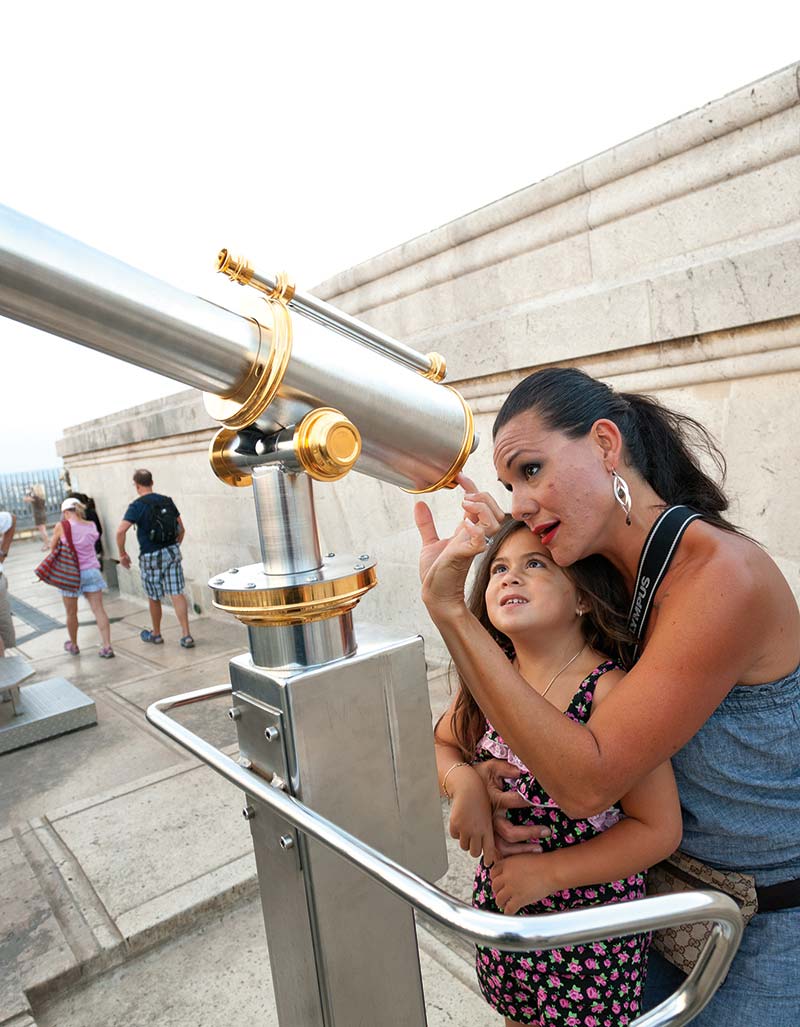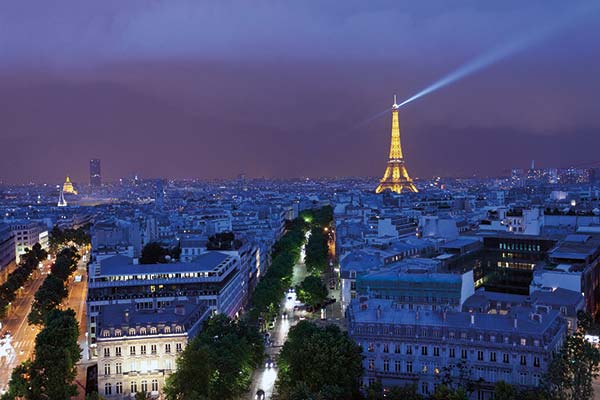
Paris—the City of Light—has been a beacon of culture for centuries. As a world capital of art, fashion, food, literature, and ideas, it stands as a symbol of all the fine things human civilization can offer.
Two thousand years ago, Paris was a humble Celtic fishing village by the river; today it’s a sprawling city, with a core population of 2.4 million. It offers sweeping boulevards, riverside book stalls, world-class art galleries, and farmers markets. Enjoy cutting-edge architecture, medieval tapestries, Gothic cathedrals, and an efficient Métro system that whisks you wherever you want to go. Sip un café crème with intellectuals at a sidewalk café, then step into an Impressionist painting in a tree-lined park.
Paris’ sights are incomparable. Visit Mona Lisa and Venus de Milo at the Louvre, and marvel at the buoyant art of Monet and Renoir at the Orsay. Pay homage to beloved Notre-Dame Cathedral, still recovering from a devastating fire. Zip to the top of the Eiffel Tower, and saunter down Avenue des Champs-Elysées. Take a day trip to visit the lavish palace of Versailles to understand the inevitability of the French Revolution...and the rise of democracy. Few countries can equal France’s impact on the global stage.
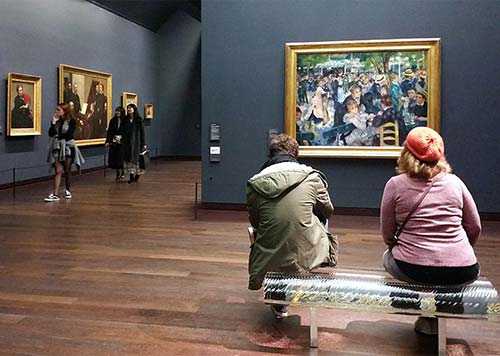
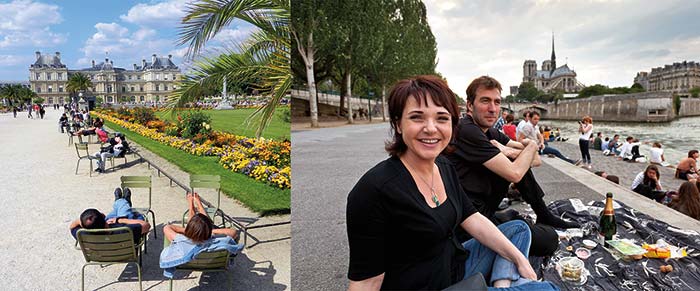
People-friendly Paris: relaxing at Luxembourg Garden; picnicking on the Seine
Yet Paris is also intimate and people-friendly. Prioritizing people over cars, the city turned riverside arterials into waterfront pedestrian promenades that run between Pont de l’Alma (near the Eiffel Tower) and the Orsay Museum on the Left Bank, and between the Louvre and Place de la Bastille on the Right Bank. The city’s many lovely parks are playgrounds for all ages. Luxembourg Garden offers puppet shows, pony rides, rental toy sailboats, and a wading pool. The Esplanade des Invalides, near Napoleon’s Tomb, is just right for afternoon lawn bowling (boules).
As you dodge Parisians walking their poodles and pushing baby strollers on a residential market street such as Rue Cler, you’ll experience real people making cozy communities in the midst of this vast, high-powered city. If you’d like to learn the fine art of living like a Parisian, a walk down a neighborhood market street provides an excellent classroom. And if you want to assemble the ultimate French picnic, there’s no better place. You’ll find a warm and human vibrancy you miss when just hopping from big museum to museum. Chat with the woman who makes your crêpe, be brave and pop into chic boutiques, and stop by a neighborhood fromagerie to sniff fragrant cheese that smells like “zee feet of angels.”
You’ll eat very well. After all, Paris offers signature dishes from all of the country’s regions: ratatouille (Provence), foie gras (Dordogne), bœuf bourguignon (Burgundy), bouillabaisse (Riviera), and much more. Dine at a cozy bistro—the table is yours for the evening. Savor a special wine with your meal, though in France, even the table wine is fine. For dessert, crack open the caramelized crust of a crème brûlée.
Save some after-dark energy for one of the world’s most romantic cities. Enjoy views over the glittering City of Light—from the Arc de Triomphe, the rooftops of stylish department stores, and the steps of Sacré-Cœur on Montmartre.
Parisians have the habit of spilling onto the river’s bridges and embankments just at that magic hour when the setting sun begins to color the evening sky. Make this your habit too. It’s the perfect time to share a picnic with friends, with an ambience that no restaurant can touch. Stately monuments and bridges, floodlit as darkness falls, are reflected in the waters of the Seine. Cruise the river and marvel at the nighttime light show at the sparkling Eiffel Tower. Once you’ve been to Paris...you’ll always have Paris.
Paris is a big city, but its major sights cluster in manageable zones. Thoughtfully grouping your sightseeing, walks, dining, and shopping can save you lots of time and money.
Paris is circled by a ring road and split in half by the Seine River, which runs east-west. North of the Seine is the Right Bank (Rive Droite), and to the south is the Left Bank (Rive Gauche). The bull’s-eye is Notre-Dame, the heart of Paris, on an island in the middle of the Seine.
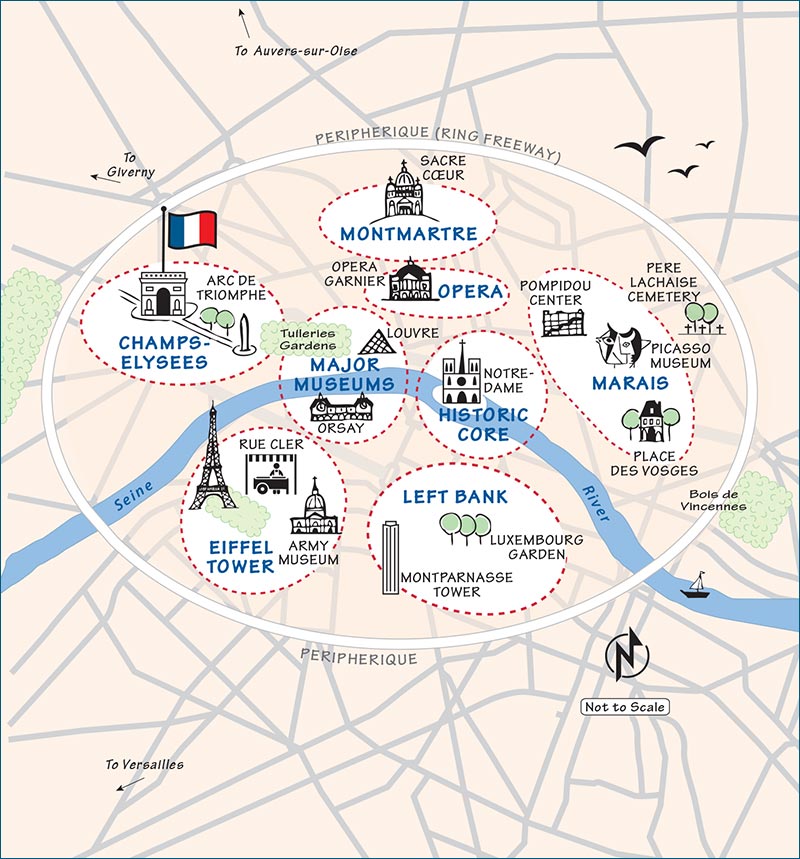
This area centers on the Ile de la Cité (“Island of the City”), located in the middle of the Seine. On this small island, you’ll find Paris’ oldest sights, from Roman ruins to the medieval Notre-Dame and Sainte-Chapelle churches. Other sights in this area: Conciergerie, Archaeological Crypt, Deportation Memorial, riverside promenade and the faux beaches of the Paris Plages, and the lovely island of Ile St. Louis, with appealing shops and eateries. Paris’ most historic riverside vendors, les bouquinistes, line both sides of the Seine as it passes Ile de la Cité.
Located just west of the historic core, this is where you’ll find the art-filled Louvre, Orsay, and Orangerie museums. Other sights are the Place de la Concorde, Tuileries Garden, Palais Royal courtyards, and the elegant arcades of the Galerie Vivienne.
The greatest of the many grand 19th-century boulevards on the Right Bank, the Champs-Elysées runs northwest from Place de la Concorde to the Arc de Triomphe. Sights in this area include the Petit and Grand Palais, Hôtel Hyatt Regency Paris Etoile (for its great city view), and on the outskirts, the modern neighborhood of La Défense with La Grande Arche.
Dominated by the Eiffel Tower, this area also boasts the color-ful Rue Cler market street (with many recommended hotels and restaurants), Army Museum and Napoleon’s Tomb, Rodin Museum, and the thriving outdoor market Marché Boulevard de Grenelle. Other sights: the pedestrian-friendly riverside promenade, Quai Branly Museum, National Maritime Museum, Architecture and Monuments Museum, and Sewer Museum. The Marmottan Museum is west of the Eiffel Tower on the Right Bank.
Vendor stalls (les bouquinistes) along the Seine; Monet’s Water Lilies at the Orangerie; Champs-Elysées with the Arc de Triomphe; Napoleon’s Tomb
Elegant Opéra Garnier; outdoor coffee break; café-lined Latin Quarter; Pompidou Center (modern art museum)
Surrounding the Opéra Garnier, this classy area on the Right Bank is home to a series of impressive boulevards and sights. Though today it’s busy with traffic, there remain hints of Paris circa 1870, when the city was the capital of the world. Along with elegant sights such as the Opéra Garnier, Jacquemart-André Museum, and Fragonard Perfume Museum, the neighborhood also offers high-end shopping: at Galeries Lafayette department store, around Place de la Madeleine and Place Vendôme, and at the covered passages of Choiseul and Ste. Anne.
The Left Bank is home to...the Left Bank. Anchored by the large Luxembourg Garden (near numerous recommended hotels and eateries), the Left Bank is the traditional neighborhood of Paris’ intellectual, artistic, and café life. Other sights: the Latin Quarter, Cluny Museum, St. Germain-des-Prés and St. Sulpice churches, Panthéon, Montparnasse Tower, Catacombs, Delacroix Museum, and the Jardin des Plantes park. This is also one of Paris’ best shopping areas (near Place St. Suplice). The Grande Mosquée de Paris and Muslim cultural center (Arab World Institute, with views) are just east of the Latin Quarter.
Stretching eastward from the Pompidou Center to the Bastille along Rue de Rivoli/Rue St. Antoine, this neighborhood is packed with recommended restaurants and hotels, shops, the delightful Place des Vosges, and artistic sights (Pompidou Center, Picasso Museum). The area is known for its avant-garde boutiques and residents. Other Marais sights: Jewish Art and History Museum, Holocaust Memorial, La Coulée Verte Promenade-Park, Père Lachaise Cemetery, Carnavalet Museum, Victor Hugo’s House, Marché des Enfants Rouges covered market, and the outdoor markets at Bastille and Place d’Aligre.
This hill, topped by the bulbous white domes of Sacré-Cœur Basilica, hovers on the northern fringes of your Paris map. Home to recommended hotels and restaurants, Montmartre retains some of the charm that once drew Impressionist painters and turn-of-the-century bohemians. Other sights are the Dalí and Montmartre museums, Moulin Rouge, Pigalle district, and nearby Puces St. Ouen flea market.
When you’re ready to explore beyond Paris, you have good options, all easily reached by train:
Versailles is Europe’s ultimate royal palace—all others are wannabes. It’s huge, comprising the Château, Gardens, and the Trianon Palaces and Domaine de Marie-Antoinette.
Other grand châteaux within day-tripping distance of Paris are the exquisite Vaux-le-Vicomte, lavish Fontainebleau, and scenically set Chantilly.
Chartres’ historic cathedral has famous stained-glass windows and statues that gloriously tell the entire story of the Bible. The pedestrian-friendly town itself is worth strolling.
Giverny and Auvers-sur-Oise are for lovers of art and small towns. The flower-filled village of Giverny was the home of Monet and his photogenic water lilies. Van Gogh spent the end of his short life painting furiously in the rural village of Auvers-sur-Oise.
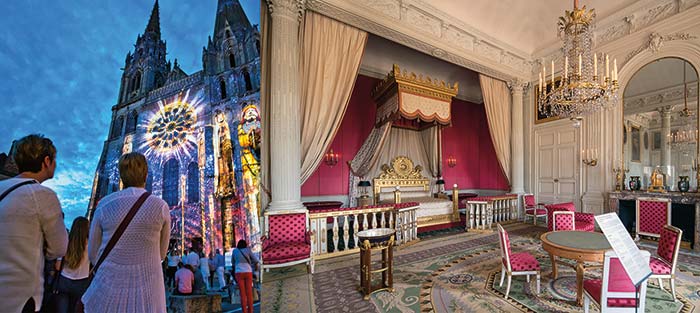
Sound-and-light show at Chartres Cathedral; Versailles’ Grand Trianon—fit for a king
The best trips start with good planning. Here are ideas to help you decide when to go, design a smart itinerary, set a travel budget, and prepare for your trip. For general advice on sightseeing, accommodations, restaurants, and more, see the Practicalities chapter.
As you read this book and learn your options...
Late spring and fall bring the best weather and the biggest crowds. May, June, September, and October are the toughest months for hotel-hunting—don’t expect many deals. Summers are generally hot and dry; if you wilt in the heat, look for a room with air-conditioning. Rooms are easy to land in August (some hotels offer deals), and though many French businesses close in August, you’ll hardly notice.
Paris makes a great winter getaway (see the Paris in Winter chapter). Airfare costs less, cafés are cozy, and the city feels lively but not touristy. The only problem—weather—is solved by dressing warmly, with layers. Expect cold (even freezing lows) and rain (hats, gloves, scarves, umbrellas, and thick-soled shoes are essential). For specific temperatures, see the climate chart in the appendix.
The following day plans offer suggestions for how to maximize your sightseeing, depending on how many days you have. You can adapt these itineraries to fit your own interests. To find out what days sights are open, check the “Daily Reminder” in the Orientation chapter. Note major sights where advance tickets are required (or smart) and a free Rick Steves audio tour is available.
| Morning | Follow my Historic Paris Walk, featuring Ile de la Cité, Notre-Dame, the Latin Quarter, and Sainte-Chapelle. If you enjoy medieval art, visit the Cluny Museum. |
| Afternoon | Tour the Louvre. |
| Evening | Enjoy a twilight ride up the Eiffel Tower and the Place du Trocadéro scene at its feet. |
| Morning | Follow my Champs-Elysées Walk from the Arc de Triomphe down the grand Avenue des Champs-Elysées and into the Tuileries Garden (or take the Métro). |
| Midday | Cross the pedestrian bridge from the Tuileries Garden, then tour the Orsay Museum. |
| Afternoon | Tour the Rodin Museum or the Army Museum and Napoleon’s Tomb. |
| Evening | Take a tour by bus, taxi/Uber, or retro-chic Deux Chevaux car. (If staying more than two days, you could save this for your last-night finale.) |
| Morning | Catch RER/Train-C to Versailles, then tour the Château and sample the Gardens. |
| Afternoon | Versailles can take up a full sightseeing day, but if you’re back in Paris, consider a sight near one of the RER/Train-C stations: the Army Museum and Napoleon’s Tomb, Rodin Museum, or Orsay Museum—or enjoy my Left Bank Walk. |
| Evening | Cruise the Seine River or have dinner on Ile St. Louis, then take a floodlit walk by Notre-Dame. |
Pyramids at the Louvre; Deux Chevaux driving tour; portico at Versailles; wintertime fun at the Eiffel Tower
| Morning | Follow my Historic Paris Walk, featuring Ile de la Cité, Notre-Dame, the Latin Quarter, and Sainte-Chapelle. Savor a break in Luxembourg Garden and consider a visit to the nearby Panthéon or Cluny Museum. |
| Afternoon | Tour the Opéra Garnier, then enjoy rooftop views at the Galeries Lafayette or Printemps department stores—or both. |
| Evening | Take a boat cruise on the Seine. |
| Morning | Tour the Louvre. |
| Afternoon | Follow my Champs-Elysées Walk from the Arc de Triomphe to the Tuileries Garden, and possibly take in the Orangerie Museum. Reversing the morning and afternoon activities also works well. |
| Evening | Enjoy dinner on Ile St. Louis, then a floodlit walk by Notre-Dame. |
Glitzy Galeries Lafayette; ready for a Seine cruise; Versailles’ pastoral Domaine de Marie-Antoinette
| Morning | Tour the Orsay Museum. |
| Midday | Tour the Rodin Museum (café lunch nearby or in gardens). |
| Afternoon | Visit the Army Museum and Napoleon’s Tomb, then take my Rue Cler Walk and relax at a café. Take a slow stroll along the Left Bank riverside promenade between the Orsay and Pont de l’Alma (near the Eiffel Tower), or bike along either bank. |
| Evening | Take one of the recommended nighttime bus/taxi/retro car tours. |
| Morning | Take RER/Train-C to Versailles and tour the palace’s interior. |
| Midday | Have lunch in the Gardens at Versailles. |
| Afternoon | Tour the Gardens, Trianon Palaces, and Domaine de Marie-Antoinette. (Late risers should reverse this plan and tour the palace’s interior in the afternoon to minimize crowd frustrations.) Or return to Paris and do this book’s Montmartre Walk. |
| Evening | Dine in Versailles town or back in Paris. |
| Morning | Follow this book’s Marais Walk and tour the Carnavalet. Have lunch on Place des Vosges or Rue des Rosiers. |
| Afternoon | Choose from these Marais sights: Pompidou Center, Jewish Art and History Museum, Picasso Museum, or Père Lachaise Cemetery. |
| Evening | Enjoy a twilight ride up the Eiffel Tower and the Place du Trocadéro scene nearby. |
| Morning | Spend most of your day at Chartres or a half-day touring the château of Vaux-le-Vicomte or Fontainebleau. |
| Afternoon | Explore the shopping districts of Paris (follow the Left Bank Walk or see the Shopping in Paris chapter for options). |
| Evening | Walk the Champs-Elysées to take in the nighttime scene. Hike to the top of the Arc de Triomphe. |
There’s still plenty to do: more shopping and cafés, Luxembourg Garden, Bus #69 tour followed by Père Lachaise Cemetery, Montmartre, Sacré-Cœur, Jacquemart-André and Marmottan museums, day trips to Vaux-le-Vicomte and/or Fontainebleau, and Disneyland Paris.
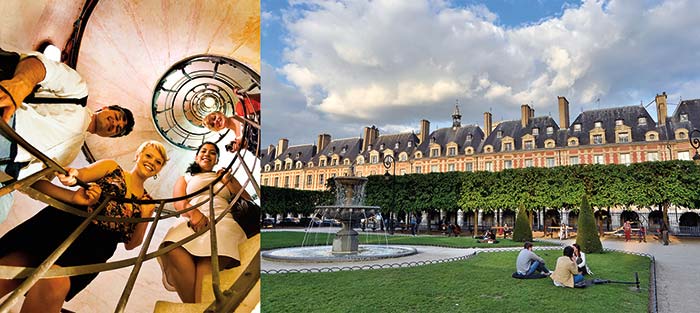
Spiraling up the Arc de Triomphe; winding down at peaceful Place des Vosges
Run a reality check on your dream trip. You’ll have major transportation costs in addition to daily expenses.
Flight: A round-trip flight from the US to Paris costs about $900-2,200, depending on where you fly from and when.
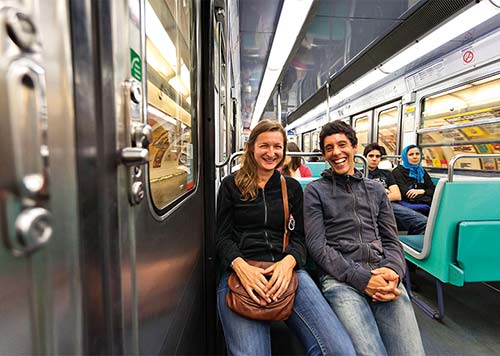
Public Transportation: For a one-week visit, allow about $35 for a Métro/bus/RER pass that covers a couple of day trips by train. To get between Paris and either major airport, figure $35-140 round-trip, depending on which option you choose.
Budget Tips: To cut your daily expenses, take advantage of the deals you’ll find throughout Paris and mentioned in this book.
Use public transportation, and visit sights by neighborhood for efficiency.
Buy a Paris Museum Pass and use it wisely. On days that you don’t have pass coverage, visit free sights and those not covered by the pass (see the “Affording Paris Sightseeing” sidebar in the Sights in Paris chapter). Take advantage of free experiences (people-watching counts).
Some businesses—especially hotels and walking-tour companies—offer discounts to my readers (look for the RS% symbol in the listings in this book).
Reserve your rooms directly with the hotel and book good-value rooms early. Some hotels offer a discount if you pay in cash and/or stay three or more nights (check online or ask). Rooms can cost less outside of the peak season months of May, June, September, and October. And even seniors can sleep cheaply in hostels (most have private rooms) for about $40 per person ($70 for a private room). Or check Airbnb-type sites for deals.
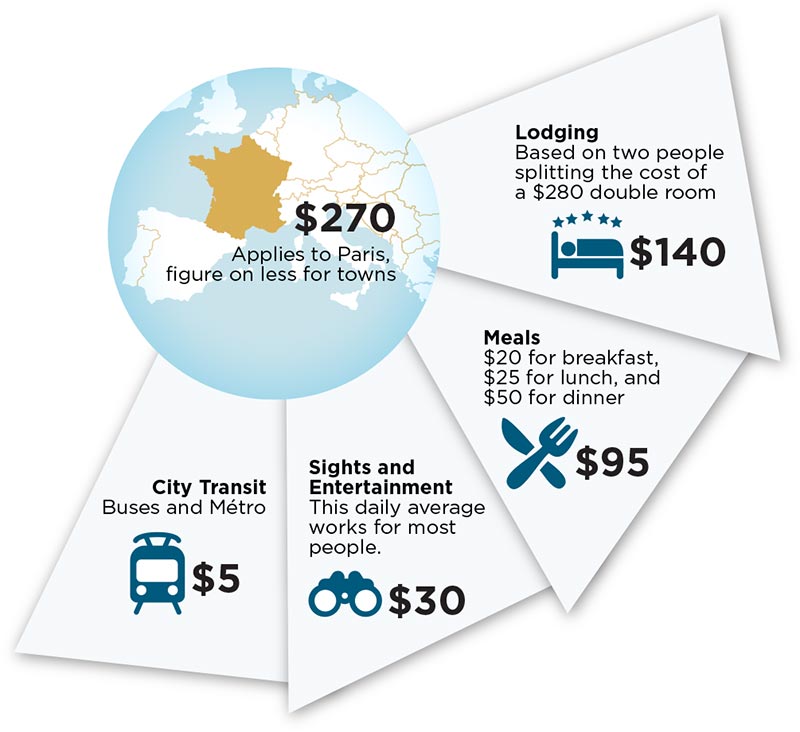
It’s no hardship to eat well on a budget in Paris. For dinner at restaurants, you can order just a plat (main course), and at cafés, it’s fine to order only soup or a salad. You can get tasty takeout food at bakeries, street stands, delis, and grocery stores. Cultivate the art of picnicking in atmospheric settings.
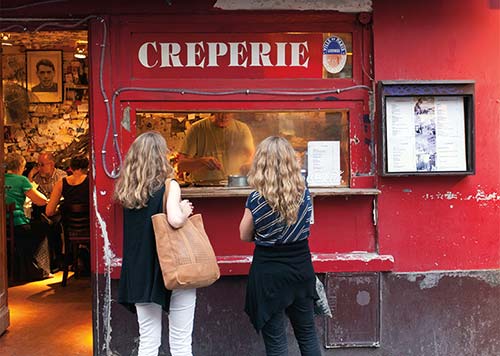
When you splurge, choose an experience you’ll always remember, such as a concert in Sainte-Chapelle, a cooking class, or a food tour. Minimize souvenir shopping; focus instead on collecting wonderful memories.
You’ll have a smoother trip if you tackle a few things ahead of time. For more details on these topics, see the Practicalities chapter and RickSteves.com, which has helpful travel-tip articles and videos.
Make sure your travel documents are valid. If your passport is due to expire within six months of your ticketed date of return, you need to renew it. Allow 12 weeks or more to renew or get a passport. Be aware of any entry requirements, and pack a copy of your vaccine record (or store it on your phone). Get passport and country-specific travel info at Travel.State.gov.
Arrange your transportation. Book your international flights. Overall, Google Flights is the best place to start searching for flights. If you’ll be traveling beyond Paris, figure out your transportation options: bus or train (and either a rail pass or individual train tickets), rental car, or a cheap flight. (You can wing it in Europe, but it may cost more.) High-speed trains (TGVs—also called “InOui”) in France require a seat reservation; book as early as possible, as seats fill fast. This is especially true if you’re traveling with a rail pass.
Book rooms well in advance, especially if your trip falls during peak season or any major holidays or festivals.
Reserve ahead for key sights. At some sights (the Louvre, Sainte-Chapelle, and Versailles), advance tickets are required. While not technically required, advance tickets are also smart for the Eiffel Tower, Orangerie, and Catacombs. This is your best bet for avoiding long ticket-buying lines at the door (though not slow-moving security lines).
Buy a Paris Museum Pass. If the pass makes sense for your trip (do the math), buy it online in advance, then use it to reserve timed-entry slots for covered sights.
Hire local guides in advance. Reserve ahead by email; popular guides can get booked up.
Consider travel insurance. Compare the cost of insurance to the cost of your potential loss. Understand what protections your credit card might offer and whether your existing insurance (health, homeowners, or renters) covers you and your possessions overseas.
Manage your money. “Tap-to-pay” or “contactless” cards are widely accepted and simple to use. You may need your credit card’s PIN for some purchases—request it if you don’t have one. Alert your bank that you’ll be using your debit and credit cards in Europe. It’s easy to withdraw euros from ATMs in Europe (and less expensive than changing money).
Use your smartphone smartly. Sign up for an international service plan or rely on Wi-Fi instead. Download any apps you’ll want on the road, such as maps, translators, and Rick Steves Audio Europe (see sidebar).
Pack light. You’ll walk with your luggage more than you think. I travel for weeks with a single carry-on bag and a day pack. Use the packing checklist in the appendix as a guide.
Navigating at the airport; sightseeing with a Paris Museum Pass; taking advantage of public transportation; enjoying a petite yet posh hotel room
If you have a positive attitude, equip yourself with good information (this book), and expect to travel smart, you will.
Read—and reread—this book. To have an “A” trip, be an “A” student. Note opening hours of sights, closed days, crowd-beating tips, and whether reservations are required or advisable. Check the latest at RickSteves.com/update.
Be your own tour guide. As you travel in Paris and beyond, get up-to-date info on sights, reserve tickets and tours, reconfirm hotels, and check transit connections. Visit local tourist information offices (TIs).
Outsmart thieves. Pickpockets abound in crowded places where tourists congregate. Treat commotions as smokescreens for theft. Keep your passport and backup cash and cards secure in a money belt tucked under your clothes; carry only a day’s spending money and a card in your front pocket or wallet. Don’t set valuable items down on counters or café tabletops, where they can be quickly stolen or easily forgotten.
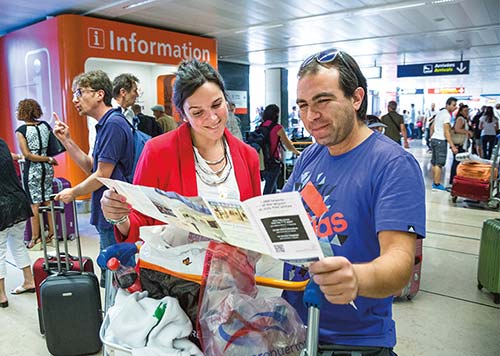
Minimize potential loss. Keep expensive gear to a minimum. Bring copies or take photos of important documents (passport and cards) to aid in replacement if they’re lost or stolen. Back up photos and devices to the cloud as you travel.
Guard your time and energy. Taking a taxi or Uber can be a good value if it saves you a long wait for a cheap bus or an exhausting walk across town. To avoid long lines, follow my crowd-beating tips, such as getting a Paris Museum Pass, buying tickets in advance, or sightseeing early or late.
Be flexible. Even if you have a well-planned itinerary, expect changes, strikes, closures, sore feet, bad weather, and so on. Your Plan B could turn out to be even better.
Attempt the language. Many French people—especially in the tourist trade and in big cities like Paris—speak English, but if you learn some French, even just a few pleasantries, you’ll get more smiles and make more friends. Apps such as Google Translate work for on-the-go translation help, but you can get a head start by practicing the survival phrases near the end of this book.

Follow the advice in this book to avoid the worst lines and crowds at Versailles. A small handwritten menu in French is often the sign of a good restaurant.
Connect with the culture. Interacting with locals carbonates your experience. Enjoy the friendliness of the French people. The French adore enthusiastic reactions to their landscapes, sights, food, and wine. Ask questions; most locals are happy to point you in their idea of the right direction. Cheer for your favorite bowler at a boules match, leave no chair unturned in your quest for the best café, and find that perfect Eiffel Tower view. When an opportunity pops up, make it a habit to say “yes.” Have a trip that’s truly magnifique.
Paris...here you come!
